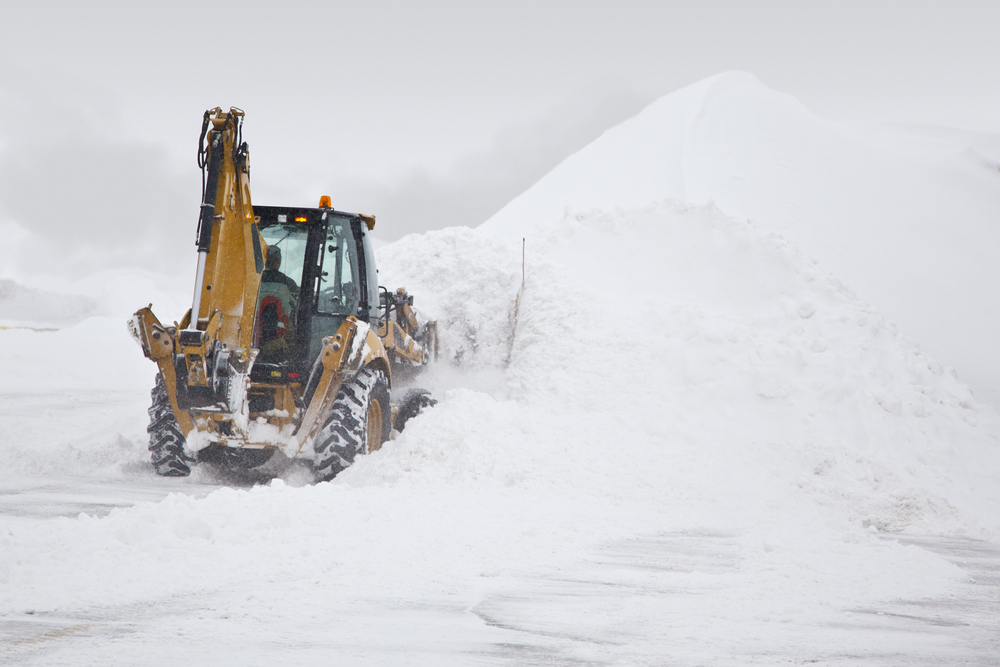Winter is coming...and so are ice hazards! Icy roads and walkways lead to more than 100,000 slips and 150,000 car crashes every winter. As a place where both cars and pedestrians travel, parking lots are especially high-risk. Commercial property owners must take precautions to prevent ice buildup on their lots. Read on to learn why deicing is important and how to achieve it.
Because ice is clear, it's difficult to see. Most non-commercial vehicles can't get sufficient traction on slick surfaces. In parking lots, where drivers are making lots of turns and quick stops, that lack of traction can be quite dangerous.
And of course, pedestrians move through parking lots as well. Slipping on ice can lead to painful falls and injuries. If you haven't properly treated your property for ice removal, you could be found liable.
Deicing your parking lot not only prevents these costly accidents but also helps your customers and employees feel safe. Even the most winter-savvy folks would rather not encounter ice at all — especially on hard pavement!
So, how can you prevent ice from sticking to your lot or remove it once it forms?

Salt — in particular, rock salt — is a tried-and-true ingredient in deicing. Composed of sodium chloride, calcium chloride, and magnesium chloride, rock salt essentially turns freshwater into brine. Saltwater has a lower freezing point, so the ice melts. The salt brine then sinks, breaking the ice free from the pavement.
However, this technique only works for existing snow and ice. While it's highly effective, people can still get injured as long as the parking lot is icy. That's why it's important to be proactive in your deicing strategy.
To prevent ice from taking hold to begin with, you use ice melt salt. It's chemically similar to rock salt, except that it has sodium acetate instead of sodium chloride (aka table salt). This formula has a much lower freezing point, so the resulting brine doesn't freeze at all. Ice melt salt is also less corrosive, causing less damage to your parking lot — and your customers' vehicles! It's more environmentally friendly as well.

Because rock salt only works on existing ice and snow, avoid using it as a pre-treatment. It's quite corrosive, which means you could be causing damage to your lot, vehicles' tires, and surrounding plant life and waterways with little preventative benefit. Apply rock salt only if your parking lot is icy and the temperature is expected to rise above 5 degrees Fahrenheit. The ice must start to melt in order for the salt to mingle with the water and break down the ice.
Brine is a better preventative solution. It doesn't freeze until the temperature drops below 20 degrees Fahrenheit. However, if it's already in place before the temperature drops, ice won't stick to your pavement. Aim to apply ice melt salt when the temperature is between 20 and 30 degrees Fahrenheit and when there's no rain in the forecast.
Whether you're applying rock salt or ice melt salt, it's important to put down enough to treat your lot — but not too much that the salt washes away before it has a chance to work. (That can also destroy your landscaping.) Plus, salt is expensive, especially ice melt salt.
Unfortunately, there's no simple answer for how much salt you need to deice. The colder it is, the more salt you need. The thicker the layer of snow or ice, the more you need. And of course, you'll need to use the right type of salt depending on weather conditions.
As a general guideline, aim to use 2.3 pounds per 1,000 square feet if the pavement is 28-32 degrees Fahrenheit (.e. just below freezing). Add 2.2 pounds per 1,000 feet for every 5-degree decline.
For example:
Below 15 degrees, you can only use ice melt salt, i.e. magnesium chloride and/or calcium chloride. You can cut these amounts in half if you wet the salt or pre-treat with brine.
If you pretreat with brine, you can reduce your rock salt needs. Remember that rock salt is only effective down to 15 degrees Fahrenheit. Below that, you need a formula with calcium chloride, potassium acetate, or magnesium chloride.
In sum, deicing a parking lot requires lots of calculations, proactive methods, and constant attention to the weather forecast. Countless business owners waste money by putting down rock salt in freezing temperatures or using the wrong type of salt.
Save yourself a headache and keep both your employees and customers safe with expert deicing, snow removal, and ice presentation by hiring Puget Construction and Landscape.
Contact us to get on a Snow Removal & De-icing Plan
Winter is coming, with means a few different things. First, you’ll have to bundle up and stay in to avoid the flu and other illnesses. More importantly, however, the arrival of winter means the arrival of snow, which you’ll have to wipe from your parking lot and from around your walkways. Snow removal is highly laborious, but it’s also a critical strategy to make sure you and your customers aren’t injured and that everyone can get where they need to be on a moment’s notice.
Many businesses hesitate to start their snow removal plan, but this is always a mistake. You’ll want to plan for your snow removal plan several months before the winter season actually arrives, in order to properly budget and act when the winter does finally arrive. Even if you’ve been slow to plan for this year’s winter, there are still several strategies you can employ on only a few weeks’ notice to keep your family safe and your life moving as it should be.
Most importantly, you’ll want to book with a reliable, knowledgeable snow removal & ice management contractor this very moment, because most contractors are booked up when the season arrives. If you have a relationship with a current landscape company, you should do whatever you can to leverage it; ask them for assistance with snow and get to know their policies and rates before the winter arrives.
Most landscape contractors provide snow removal services in a litany of options and rates. Don’t overthink the process, hire whoever you trust and respect to work on and around your yard and driveway. On top of having a contractor in your back pocket, there are three more strategies you should use to ensure you’ll be ready when winter hits.
" When it comes to weather, communication is key. Weather can be unpredictable, so you need to have a plan for how you will quickly communicate with employees and customers when a winter storm interferes with your company’s usual routine. "
While this may tip may seem somewhat paranoid at first glance, it’s extremely important to prevent the weather predictions’ influence your decision. Weather which won’t bring several inches of snow is great, and weathermen predicting this trend on a given year is also great, but those who have prepared for the worst will be those most equipped to deal with the worst if the weathermen is wrong.
You should plan and budget for a tough winter no matter what the weatherman is telling you on any given day several weeks or months out from the actual winter season. Don’t plan for a moderate winter, either; plan for a winter which you gauge to be snowier and colder than normal.
This way, you’ll always be operating optimally, ready for whatever mother nature can throw at you. Save up about five to ten percent more than you think is necessary for your winter fund and buy equipment which you think may be just a bit too nice and efficient for the job you think you’ll have.
If the winter is light, great! You’ll be done in no time thanks to your precautions, and you can spend that money you’ve saved or continue to keep it locked away for a rainy day. If the winter is every bit as heavy as you planned for, you’ll be in great shape to deal with the hassles and obstacles of a heavy winter. It’s a win-win situation.
When the winter arrives, you’ll want to keep up with your plans and adjust according to the weather. Heavy snow winters can be difficult to navigate, but keeping your wits and awareness about you is a great way to stay ahead of the weather and minimize mistakes and damage. Like a great business, you’ll want to assess which of your strategies for snow combat are working and which aren’t, keeping and improving on those which are effective and discarding those which just don’t get the job done.
There are a few specific things you can check for, even in the middle of a heavy winter. These things include: which side of your house is getting the most sun, and how much worse is the snow and ice on that side? Will you need to take extra precautions and work at a greater frequency because of the extra snow and ice? Is all of your drainage working properly when the snow melts, or is that going to be another fix which must be made?
Are you snow piles in a good location or are they endangering your house in some way? Is snow which has melted than refrozen causing problems in your walkways and driveway? Can you see new cracks beginning to form? Is the contractor you’re working with doing a satisfactory job?
Answering these types of questions can make you far more prepared to handle the snow than before the winter season. Adjusting on the fly is a difficult but valuable skill to have, especially in the winter months.

Don’t fret if you’re too late for this step already, you can always do it next year. It’s a totally optional but helpful step in your quest to prepare totally and absolutely for the winter months. During the spring and summer, you should walkthrough your property with a trusted contractor. Ask him about your snow plan and any improvements which can be made, including any holes present in the plan.
This step may seem extraneous – and in some ways it is – but that’s really the point. The best defense is a good offense, meaning everything you can do to double check your plan and plan for every contingency will make you extra prepared if anything major does occur. You’ll also have plentiful time to prepare during the spring and summer seasons if you start early, getting an early start on your strategies and tactics to plan for the winter months.
You can preplan where to put snow piles, chemicals, and ice to minimize damage and mitigate risk to your property and family. The warm temperature may make you think you’re crazy, but you’re really just smart, planning ahead for when the weather changes and the danger increases in a multitude of ways.

Create a Snow Removal & Ice Management Plan Today!
Winter is nearly here. Take this time, in the coming weeks, to prepare the best you can for its arrival and know how you’ll react to emergencies while doing your best to prevent them. Even with winter already almost here, you should do your best to plan for the worst, know your property, and talk to a contractor about protecting your property when the time comes. There are many landscapers who would be happy to walk you through the basics and amend your plan in a few key areas. The winter can be a tough time for homeowners, but there are many ways you can prepare to know exactly what you’re doing and why.